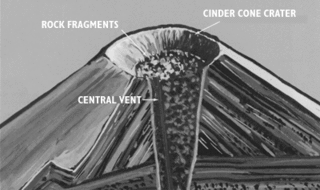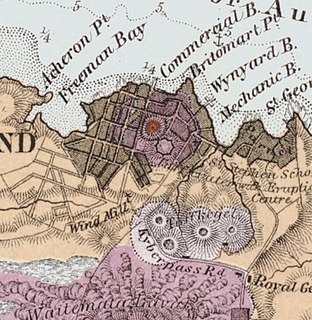Related Research Articles

Mount Ruapehu is an active stratovolcano at the southern end of the Taupō Volcanic Zone in New Zealand. It is 23 kilometres (14 mi) northeast of Ohakune and 23 km (14 mi) southwest of the southern shore of Lake Taupō, within the Tongariro National Park. The North Island's major ski resorts and only glaciers are on its slopes.

The Ring of Fire is a region around much of the rim of the Pacific Ocean where many volcanic eruptions and earthquakes occur. The Ring of Fire is a horseshoe-shaped belt about 40,000 km (25,000 mi) long and up to about 500 km (310 mi) wide.

Rangitoto Island is a volcanic island in the Hauraki Gulf near Auckland, New Zealand. The 5.5 km (3.4 mi) wide island is a symmetrical shield volcano cone, reaching a height of 260 m (850 ft). Rangitoto is the youngest and largest of the approximately 50 volcanoes of the Auckland volcanic field, having formed in an eruption about 600 years ago, and covering an area of 2,311 ha. It is separated from the mainland of Auckland's North Shore by the Rangitoto Channel. Since World War II, it has been linked by a causeway to the much older, non-volcanic Motutapu Island.

Whakaari / White Island, commonly known as White Island or Whakaari, is an active andesite stratovolcano situated 48 km (30 mi) from the east coast of the North Island of New Zealand, in the Bay of Plenty. The island covers an area of approximately 325 ha, which is just the peak of a much larger submarine volcano.

The Auckland volcanic field is an area of monogenetic volcanoes covered by much of the metropolitan area of Auckland, New Zealand's largest city, located in the North Island. The approximately 53 volcanoes in the field have produced a diverse array of maars, tuff rings, scoria cones, and lava flows. With the exception of Rangitoto, no volcano has erupted more than once, but eruptions lasted for various periods ranging from a few weeks to several years. Rangitoto erupted twice; the first eruption occurred about 600 years ago, followed by a second eruption approximately 50 years later. The field is fuelled entirely by basaltic magma, unlike the explosive subduction-driven volcanism in the central North Island, such as at Mount Ruapehu and Lake Taupō. The field is currently dormant, but could become active again.

The Panmure Basin, also sometimes known as the Panmure Lagoon, is a tidal estuary within a volcanic crater or maar in New Zealand's Auckland volcanic field, which erupted approximately 25,200 years ago. It is located to the south of Panmure town centre.

A cinder cone is a steep conical hill of loose pyroclastic fragments, such as volcanic clinkers, volcanic ash, or cinder that has been built around a volcanic vent. The pyroclastic fragments are formed by explosive eruptions or lava fountains from a single, typically cylindrical, vent. As the gas-charged lava is blown violently into the air, it breaks into small fragments that solidify and fall as either cinders, clinkers, or scoria around the vent to form a cone that often is symmetrical; with slopes between 30 and 40°; and a nearly circular ground plan. Most cinder cones have a bowl-shaped crater at the summit.

Ōhinerau / Mount Hobson is a 143 m high volcanic cone in the Auckland volcanic field in Auckland, New Zealand.

Ōhuiarangi / Pigeon Mountain is a 55 m (180 ft) high volcanic cone at Half Moon Bay, near Howick and Bucklands Beach, in Auckland, New Zealand. The cone forms the last part of volcanic activity that lasted many years. An earlier explosive eruption, created the prominent tuff ring that is still clearly visible extending in an arc south of Sunderlands Road. Two much smaller craters were formed to the north west of the main cone. The smaller lies buried under Pigeon Mountain Road outside number 18, and the other forms 'Heights Park' – a private reserve for the owners of 29 – 41 Pigeon Mountain Road and 14 – 36 Prince Regent Drive and 33 – 39 Tyrian Close. It forms part of the Auckland volcanic field and is popular for scientific school trips.

The volcanism of New Zealand has been responsible for many of the country's geographical features, especially in the North Island and the country's outlying islands.

The geology of New Zealand is noted for its volcanic activity, earthquakes and geothermal areas because of its position on the boundary of the Australian Plate and Pacific Plates. New Zealand is part of Zealandia, a microcontinent nearly half the size of Australia that broke away from the Gondwanan supercontinent about 83 million years ago. New Zealand's early separation from other landmasses and subsequent evolution have created a unique fossil record and modern ecology.

Mt Matavanu is an active volcano on the island of Savai'i in Samoa. The volcano was formed during an eruption in 1905. Lava flows from the eruption covered a large area of land in the Gaga'emauga district, leading to the relocation of several villages.
The Puhinui Craters are located in Auckland's Puhinui Reserve and are part of the Auckland volcanic field in the North Island of New Zealand. They were first recognised as volcanic craters in 2011. A cluster of three small maar craters like these is unique in the Auckland volcanic field. Their ages are unknown but most probably all three erupted during the same eruptive episode. They could have been associated with the eruption of nearby McLaughlins Mountain but this is speculation at present.

Maungawhau / Mount Eden is a scoria cone in the Mount Eden suburb of Auckland, New Zealand.

Maungarei / Mount Wellington is a 135-metre volcanic peak located in the Auckland volcanic field of Auckland, New Zealand. It is the youngest onshore volcano of the Auckland volcanic field, having been formed by an eruption around 10,000 years ago. It is the largest of Auckland's scoria cones and has a near-circular base with a flattish rim and three small craters. It is situated in the Mount Wellington suburb of East Auckland.

Te Tātua-a-Riukiuta is a volcano in Three Kings, New Zealand that erupted 28,500 years ago. The volcano had three prominent peaks and a number of smaller peaks until most of them were quarried away, leaving a sole remaining large peak called Big King.

David Timothy Gibson is the founder of New Zealand film production company The Gibson Group. After its sale in 2013 to his business partners, he was appointed CEO of the New Zealand Film Commission.

The Banks Peninsula Volcano is an extinct volcanic complex to the east of Christchurch on New Zealand's South Island. While the volcano is highly eroded it still forms the majority of Banks Peninsula with a highest point of 919 metres (3,015 ft). It is a composite of two main eruptive centers one originating at Lyttelton Harbour, the other at Akaroa Harbour. The eruptions were predominantly basaltic, with associated andesite and trachytes, with minor rhyolite. The volcanic activity occurred in the Late Miocene and possibly extended into the Early Pliocene. There are four volcanic groups, all of which are within the Māui Supergroup. The Christchurch earthquakes led to rumors of a possible eruption, however, there is no known magma chamber beneath the volcano and there has not been any sign of volcanic activity in the last 5 million years.

On 9 December 2019 Whakaari / White Island, an active stratovolcano island in New Zealand's northeastern Bay of Plenty region explosively erupted. The island was a popular tourist destination, known for its volcanic activity, and 47 people were on the island at the time. Twenty-two people died, either in the explosion or from injuries sustained, including two whose bodies were never found and were later declared dead. A further 25 people suffered injuries, with the majority needing intensive care for severe burns. The ongoing seismic and volcanic activity in the area as well as heavy rainfall, low visibility and toxic gases hampered recovery efforts over the week following the incident.

The Albert Park Volcano was one of the volcanoes in the Auckland volcanic field in New Zealand. A small volcano that erupted approximately 145,000 years ago, the volcanic remnants were quarried during the early colonial history of Auckland between 1840 and 1869. The volcano was dwarfed by the pre-volcanic sandstone ridge of Albert Park directly to the south-east, and only recognised as volcanic by Ferdinand von Hochstetter when he visited Auckland in 1859.
References
- 1 2 Smith, Jacqueline (25 September 2010). "Auckland's hot spots spark disaster drama". The New Zealand Herald . Retrieved 10 June 2021.
- ↑ "Eruption". Gibson Group. Retrieved 10 June 2021.
- 1 2 3 4 "Wellington production firm 'destroys' Auckland". The Dominion Post . 13 October 2010. Retrieved 10 June 2021.
- 1 2 "Eruption". NZ On Screen . Retrieved 10 June 2021.
- ↑ "Scriptwriter Graeme Tetley dies". The New Zealand Herald . 14 March 2011. Retrieved 10 June 2021.
- ↑ Smith, Richard; Lowe, David J.; Wright, Ian. "Volcanoes - Cone volcanoes and volcanic fields". Te Ara: The Encyclopedia of New Zealand . Retrieved 10 June 2021.
- ↑ "TV Pick of the week: Eruption". The New Zealand Herald . 7 October 2010. Retrieved 10 June 2021.